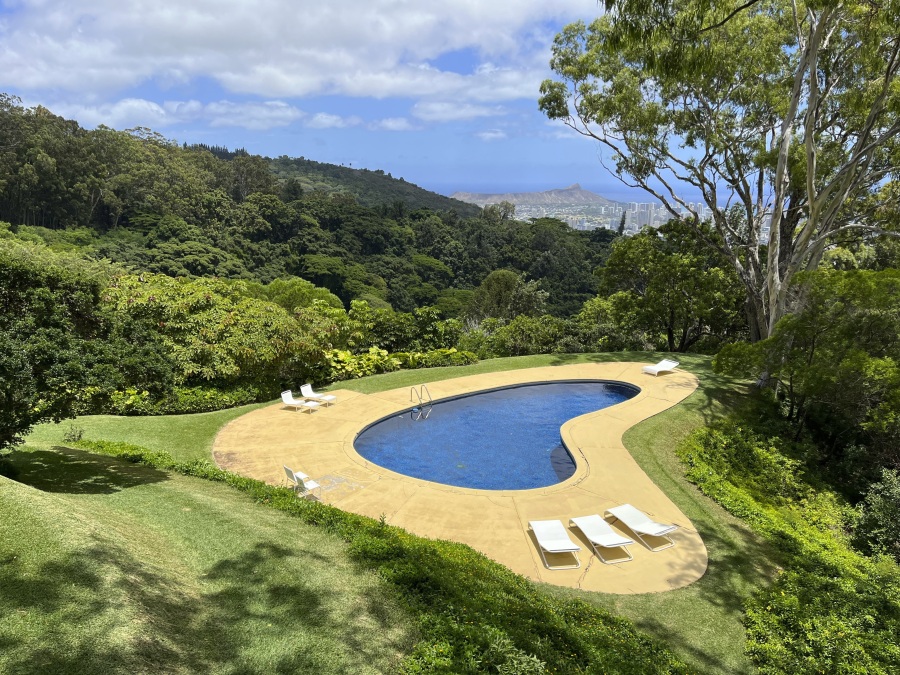There’s a mountain on Oahu named for the Greek myth of Tantalus, for whom satisfaction was always just out of reach. The road up is winding, filled with switchbacks, hanging vines and vistas where, on mild nights, couples linger in cars against the backdrop of Honolulu’s city lights.
Hidden amid wild avocado trees and the heart-shaped leaves of houseplants is a long driveway leading to a crystallized snapshot in time: the Liljestrand House, designed by architect Vladimir Ossipoff in 1948 and built for Betty and Howard Liljestrand in 1952 for $40,000 at the time.
Credited with adapting midcentury modern for the tropics, Ossipoff designed homes and buildings in Hawaii with certain shared features: Japanese carpentry and expertise, the strategic use of trade winds for cooling (he abhorred air conditioning), and the merging of outside and inside space.
This style, now known as Hawaiian Modern, is on display in the Liljestrand House, one of Oahu’s many historic homes — and one of the few that is open to visitors.
Others include the royal residences (Iolani Palace and Queen Emma Summer Palace); Hawaiian Mission Houses (such as Hawaii’s oldest Western-style house, built in 1821); Hawaii’s Plantation Village in Waipahu, which includes restored sugar plantation buildings; and Shangri-la, an ode to Islamic art and culture built by tobacco heiress Doris Duke in the 1930s.
The oldest hale — a traditional Native Hawaiian thatched house — is enshrined at the Bishop Museum, where it was built on site in 1902.
While these historic homes vary in style and grandeur, each adds something to Oahu’s character.
The structures are attuned to their natural environment and add to the state’s sense of place, said Kiersten Faulkner, executive director of the Historic Hawaii Foundation: “In Hawaii, of course, that’s all rooted in Native Hawaiian culture, local building materials.”
Builders often looked to the past for inspiration, she said. That includes using traditional features like pili grass thatching and rock walls made from local volcanic stone.
After Western contact, the architecture evolved to incorporate joinery, with techniques that came out of shipbuilding, Faulkner said, and skilled carpenters from Japan popularized pocket doors and single-wall construction. Missionaries brought whitewashing and fenced gardens; sugarcane and pineapple plantations popularized arts-and-crafts-style bungalows, where workers lived.
“Hawaii starts to be this place where all of these traditions come together,” Faulkner said. “It really did form a unique style. Much of it is oriented to the trade winds and to take advantage of natural ventilation … to be light on the land, really.”
Hawaii is hard on preservationists. Between heat, wood rot, fire risk and termites, the islands cultivate the idea of impermanence. But the greatest threat is development, Faulkner said.
“Hawaii has exceptionally high land value, and so there’s often pressure to redevelop — anything — to a more intense commercial use,” she said. “It takes a lot of commitment to say we’re going to keep something that’s important to us, even in the face of that kind of pressure.”
Remarkably little of Hawaii’s 20th-century architecture has been preserved, especially in urban areas, said William Chapman, dean of the school of architecture at the University of Hawaii at Manoa.
The mid-20th century was a particularly harsh period for historic buildings in Honolulu, he said: “We lost a lot.” What’s left is “probably two handfuls of buildings, dating back in time to the pre-territorial period, back to the 19th century.”
Developers use neglect as an excuse to tear down buildings, Chapman said: “Old-timers love to talk about the house being held together because the termites hold hands, right? I get sick of that.”
The Manoa Heritage Center, created in 1996 by Sam and Mary Cooke, hopes to survive by making the transition from historic home to house museum.
Built in 1911 by architects Walter Emory and Marshall Webb in a half-timbered style that harks back to Tudor England, the home has a basalt rock foundation. The property also has an educational center, several gardens, and the area’s last extant agricultural heiau, a stone platform and traditional place of worship.
The heiau and gardens are open to visitors, more than half of whom are local schoolchildren, Leung said, and in three to five years, the center hopes to open the doors of the historic home itself to visitors.



